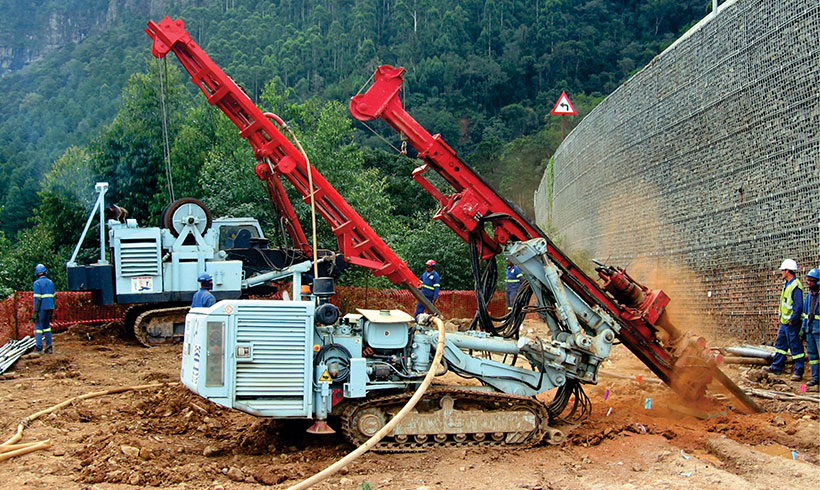Locating the very best Geotechnical Companies in South Africa: Key Considerations
Wiki Article
The Significance of Geotechnical Engineering in Dealing With Environmental Challenges and Enhancing Construction Safety
Geotechnical engineering acts as a keystone in the junction of ecological stewardship and building safety, providing vital insights into the actions of dirt and rock under different conditions. This discipline not only addresses pushing ecological difficulties such as soil erosion and groundwater protection but also improves the effectiveness of facilities versus natural risks. By carrying out critical website investigations and tailored reduction procedures, geotechnical engineers play an important duty in guarding both human lives and environmental integrity. The intricacies of these challenges elevate crucial questions regarding the future direction of this field and its ramifications for lasting advancement.
Role of Geotechnical Engineering
Geotechnical engineering plays a crucial duty in the design and building of facilities by resolving the actions of soil and rock products under numerous conditions. This field of design is essential for understanding the communication in between structures and the ground, which includes establishing the load-bearing ability of soil, assessing security, and anticipating prospective settlement or failing.Geotechnical engineers are in charge of conducting website examinations, which include sampling and testing dirt and rock to gather information on their chemical and physical residential or commercial properties. This information is important for designing structures, maintaining walls, and various other earth-retaining structures that make sure safety and security and durability. Geotechnical design notifies the choice of proper building and construction techniques and materials, thereby minimizing dangers connected with dirt behavior.
Moreover, the combination of geotechnical design concepts right into city planning and ecological monitoring is crucial for resolving difficulties such as ground contamination and groundwater monitoring. By recognizing geotechnical variables, designers can create lasting solutions that enhance the resilience of facilities against natural risks, while likewise advertising environmental stewardship. Inevitably, the function of geotechnical design is vital for attaining safe, durable, and ecologically conscious building practices.
Dirt Disintegration Mitigation
Dirt disintegration presents a substantial danger to both ecological stability and infrastructure integrity, influencing approximately 24 billion lots of abundant soil shed each year worldwide. This sensation is intensified by factors such as logging, urbanization, and bad farming methods. Geotechnical engineering plays a pivotal role in creating efficient dirt disintegration reduction strategies that guard both the setting and building projects.One approach involves the execution of erosion control techniques such as plants planting, which stabilizes dirt with root systems. Furthermore, the construction of keeping balconies and walls can effectively reduce surface area overflow and secure vulnerable locations from disintegration. Proper water drainage style is also crucial; it minimizes water build-up and routes excess drainage far from critical frameworks.
Furthermore, geotechnical designers employ dirt stabilization methods, such as the application of geotextiles and naturally degradable floor coverings, to enhance dirt cohesion and protect against deterioration - geotechnical engineer description. Normal tracking and assessment of erosion-prone sites enable timely treatments, guaranteeing long-lasting sustainability. By incorporating these approaches, geotechnical engineering not just reduces the impacts of dirt erosion however also adds to the durability of framework versus environmental challenges, eventually fostering a safer and more sustainable built environment
Groundwater Security Methods
Groundwater serves as a crucial resource for alcohol consumption water, agriculture, and commercial procedures, making its protection vital for environmental sustainability and public wellness. Effective groundwater protection methods are important in mitigating contamination threats and making sure the long life of this source.
Regular surveillance of groundwater top quality is also essential, making it possible for early discovery of contamination sources and helping with prompt removal efforts. Using advanced modern technologies, such as geophysical surveys and remote noticing, help in determining possible risks to groundwater gets.
Furthermore, public education and learning and stakeholder interaction are essential, fostering area support for groundwater defense initiatives. all about geotechnical engineering. By combining regulative actions, technological improvements, and area participation, we can create an extensive structure that safeguards groundwater sources while advertising sustainable advancement and building and construction techniques
Landslide Risk Management
Landslides present substantial hazards to both human safety and facilities, making efficient threat monitoring strategies important. Geotechnical engineering plays a crucial role in determining, analyzing, and mitigating landslide risks. A comprehensive understanding of slope stability, soil mechanics, and hydrology is important for establishing efficient danger administration plans.The very first step in landslide risk management involves comprehensive site investigations, that include geological mapping and soil testing. These investigations help engineers assess the potential for landslides by identifying crucial elements such as slope angles, soil make-up, and water web content. Making use of innovative innovations such as remote noticing and geophysical surveys can improve the accuracy of these evaluations.
Once risks are identified, appropriate mitigation steps can be carried out. These may include engineering options such as maintaining wall surfaces, drain systems, and slope stablizing methods. Moreover, checking systems should be developed to identify signs of ground movement and adjustments in water degrees, enabling aggressive interventions.

Enhancing Building Security
Building sites commonly offer a myriad of dangers that can endanger worker safety and project honesty. Geotechnical design plays a critical duty in boosting construction safety by supplying important insights right into subsurface conditions. Through extensive dirt and rock evaluation, geotechnical engineers can identify possible dangers, such as soil instability, groundwater concerns, and seismic susceptabilities, which may compromise the safety and security of building activities.Implementing geotechnical remedies, such as appropriate foundation layout and the use of retaining frameworks, reduces these risks substantially. These services not just make sure the stability of the frameworks being built yet likewise create a more secure working atmosphere for construction employees. Furthermore, rigorous surveillance and evaluation of website conditions throughout the construction process are crucial. Using advanced innovations like ground-penetrating radar and inclinometer systems enables real-time information collection, permitting prompt interventions when hazards are identified.
Moreover, promoting a culture of security via training and adherence to developed safety procedures further enhances construction site safety. By integrating geotechnical expertise into the preparation and implementation stages, building jobs can accomplish higher safety standards, ultimately protecting employees and guaranteeing effective task conclusion.
Final Thought
Finally, geotechnical engineering works as a crucial discipline in advertising and taking on environmental challenges building and construction safety and security. With effective dirt erosion mitigation, groundwater defense methods, and landslide danger management, geotechnical designers contribute to the growth of durable infrastructure. The integration of these methods promotes a safer building environment and boosts the sustainability of geotechnical specialist civil engineering tasks. Eventually, the knowledge of geotechnical designers is vital in protecting both all-natural resources and human lives versus prospective threats.Geotechnical design serves as a foundation in the intersection of ecological stewardship and building safety and security, offering vital understandings right into the behavior of soil and rock under numerous problems. Geotechnical engineering informs the selection of suitable building approaches and materials, thereby lessening threats associated with soil behavior.
Geotechnical engineering plays an essential duty in creating effective soil erosion mitigation techniques that protect both the setting and building and construction tasks.
Moreover, geotechnical engineers employ soil stabilization methods, such as the application of geotextiles and naturally degradable floor coverings, to boost dirt communication and prevent deterioration. With detailed dirt and rock evaluation, geotechnical designers can determine prospective threats, such as soil instability, groundwater issues, and seismic vulnerabilities, which may endanger the safety and security of construction activities.
Report this wiki page